Welcome to the world of blue birds in Massachusetts! Blue birds are a beautiful and captivating species of birds found in the state of Massachusetts. These birds have been a part of the Massachusetts landscape for many years and can be seen in both rural and urban areas.
They are a symbol of hope and renewal and have been a source of joy and inspiration to many people. In this article, we will explore the biology, behavior, and habitat of blue birds in Massachusetts.
We’ll also discuss the efforts of conservationists to protect and restore the blue bird population in the state. So, let’s dive in and learn more about these majestic birds.
1. Eastern Bluebird
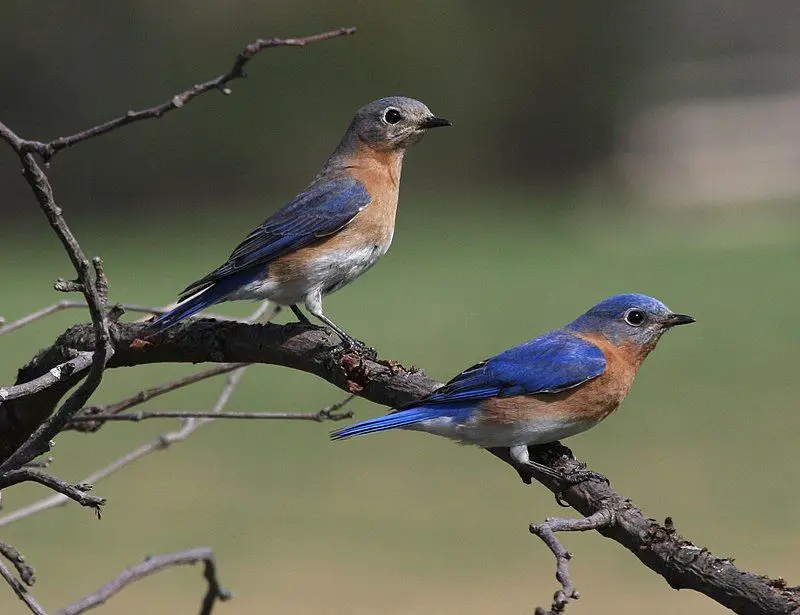
The Eastern Bluebird is a species of small, migratory thrush native to North America. It can be found in a variety of habitats, including open woodlands, farmlands, and orchards.
It is a favorite of birders due to the bright blue breeding plumage of the male, which is easily visible when perched on a wire or other open perch. The Eastern Bluebird is a small but colorful bird, with a reddish-brown breast, a grayish-blue back, and a white belly.
The upper wings are bright blue with black and white bars, while the tail is mostly black with white edges. The bill is black and the legs are gray.
The male Eastern Bluebird is more colorful than the female with a deep blue head, upperparts, and tail, while the female is mainly grayish-brown with a lighter blue tint to the wings and tail.
During the breeding season, the male Eastern Bluebird is highly territorial and will defend his territory with song and chase away intruders. He will also perform elaborate courtship displays to attract a mate.
During the non-breeding season, Eastern Bluebirds will form small flocks and migrate south, typically returning to their breeding grounds in the spring.
| Kingdom | Animalia |
| Phylum | Chordata |
| Class | Aves |
| Order | Passeriformes |
| Family | Turdidae |
| Genus | Sialia |
| Species | S. sialis |
2. Blue Jay
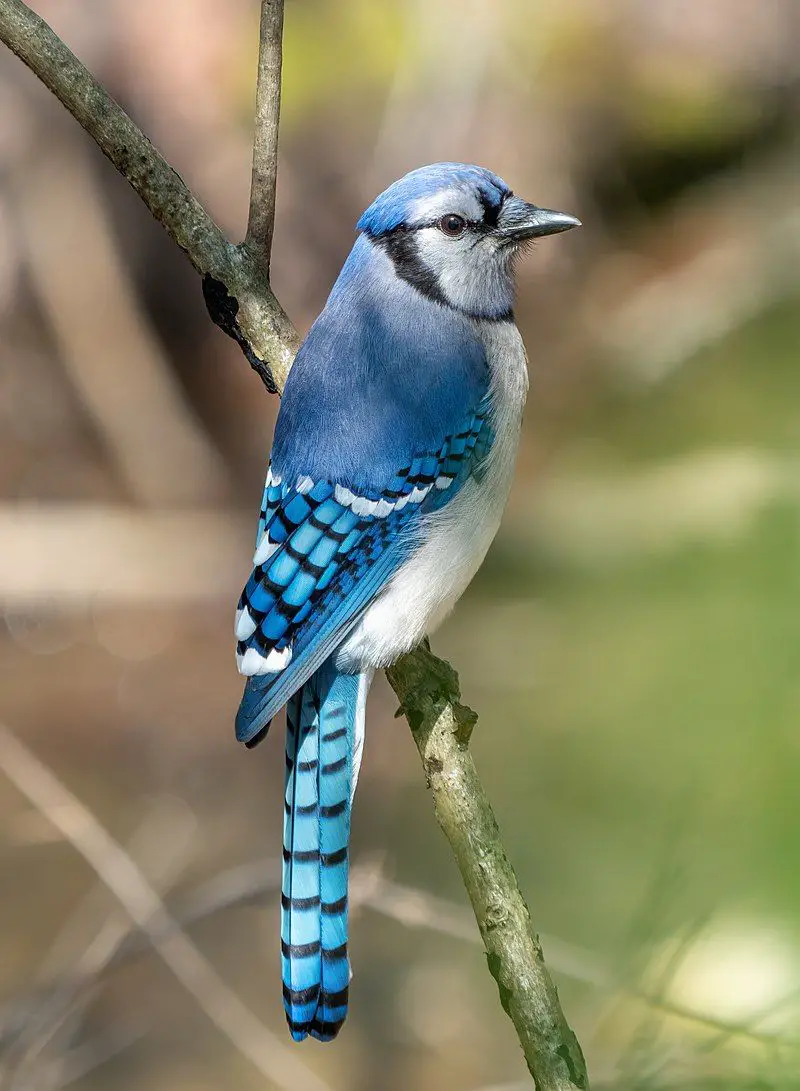
The blue jay is a species of bird found throughout much of North America. It belongs to the family Corvidae, a group of birds that includes crows and magpies.
The blue jay is native to the eastern United States and can be found in most of the eastern and central parts of the country. There are resident populations of the bird in Newfoundland, Canada, while breeding populations are spread across southern Canada.
Some eastern populations of the blue jay are migratory, meaning they travel south in the winter and north in the spring. Blue jays are known for their bright blue feathers, black and white wings, and loud calls. They are often seen in backyards, parks, and other outdoor spaces.
| Kingdom | Animalia |
| Phylum | Chordata |
| Class | Aves |
| Order | Passeriformes |
| Family | Corvidae |
| Genus | Cyanocitta |
| Species | C. cristata |
3. Barn Swallow
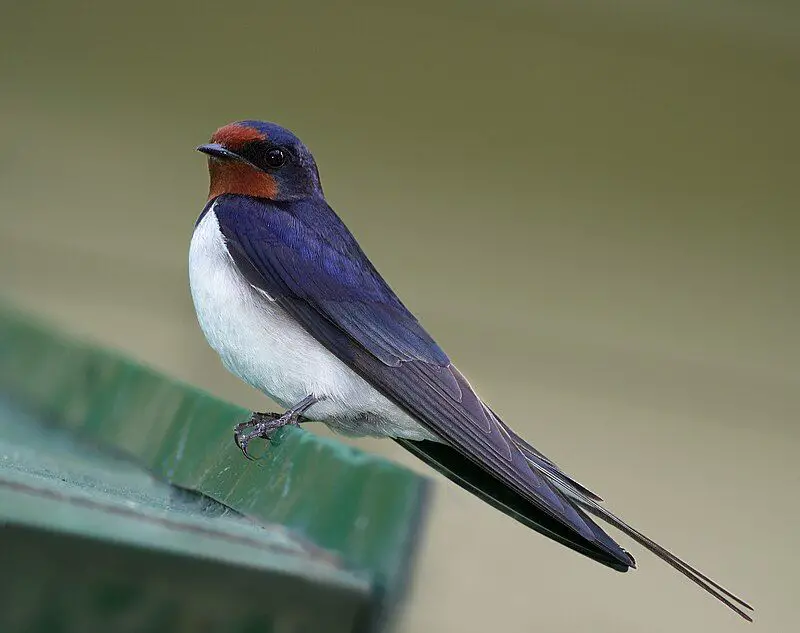
The barn swallow is a remarkable species of swallow, found in many parts of the world. It is a migratory bird, traveling long distances to find suitable habitats.
It has an impressive range, covering an area of 251 million square kilometers, making it the most widespread species of swallow in the world. The barn swallow is easily recognizable and stands out from other species due to its attractive blue upperparts and long, forked tail.
This tail is an important adaptation for the bird, as it allows it to change direction quickly when hunting for insects.
Its wings are also shaped for optimum speed, allowing the bird to fly quickly over long distances. The barn swallow is an important bird species, as it helps to control insect populations.
It feeds mainly on flying insects, which it catches by dipping and swooping through the air.
It also plays an important role in the cultural lives of many people, as it is seen as a symbol of freedom and joy. The barn swallow is a fascinating species, with many unique features and adaptations.
Its impressive range and ability to travel long distances make it a remarkable species and its cultural significance makes it a source of pride for many people around the world.
| Kingdom | Animalia |
| Phylum | Chordata |
| Class | Aves |
| Order | Passeriformes |
| Family | Hirundinidae |
| Genus | Hirundo |
| Species | H. rustica |
4. Indigo Bunting
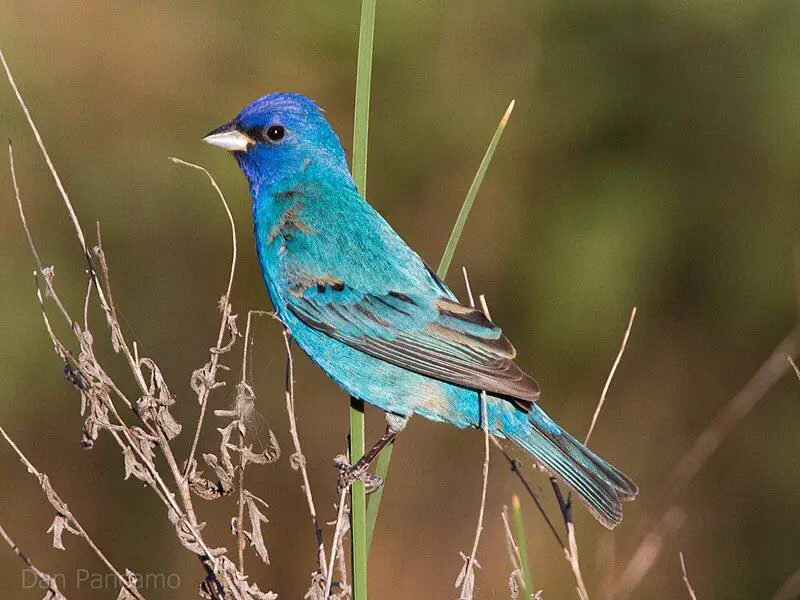
The indigo bunting is a small bird belonging to the Cardinalidae family, which mainly feeds on seeds. It has a wide range of migratory patterns, which change with the season.
During the breeding season, it can be found in southern Canada to northern Florida, while during the winter it migrates from southern Florida to northern South America.
It is interesting to note that this bird has a unique way of navigating during its migration – it uses the stars to find its way. This is an adaptation that has been passed down through generations and ensures the bird can travel safely and quickly to its destination.
This is just one example of the many adaptations that animals have developed over time in order to survive in their environment..
| Kingdom | Animalia |
| Phylum | Chordata |
| Class | Aves |
| Order | Passeriformes |
| Family | Cardinalidae |
| Genus | Passerina |
| Species | P. cyanea |
5. Black-Throated Blue Warbler
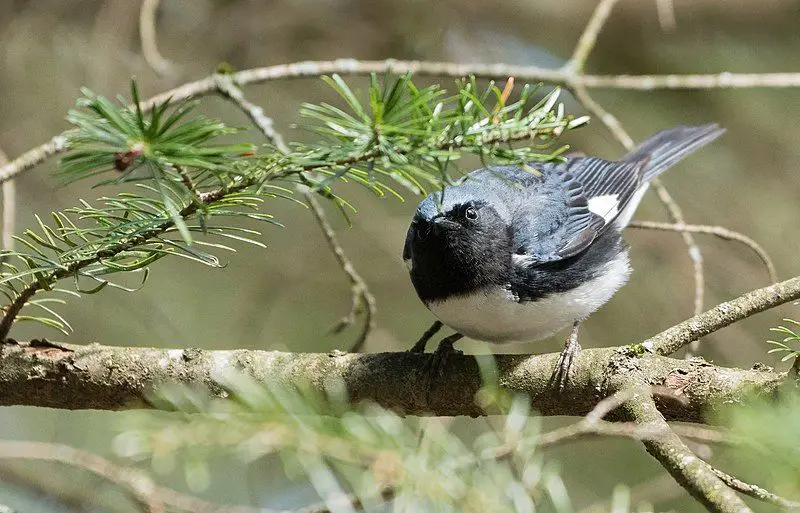
The black-throated blue warbler is a small bird species of the New World warbler family. This species is found in deciduous and mixed coniferous forests in the eastern part of North America.
During the colder months of the year, the warbler migrates to islands located in the Caribbean and Central America.
It is an important part of the ecosystem of these habitats, providing a number of benefits, including playing a role in the pollination of plants and dispersing the seeds of certain species.
The warbler also plays a role in controlling the populations of certain insects, thus helping maintain a balance in the ecosystem. The warbler’s migratory behavior also helps ensure the survival of the species by allowing it to access a variety of habitats throughout the year.
In addition, it helps ensure that the warbler can find adequate food sources in different regions at different times of the year.
| Kingdom | Animalia |
| Phylum | Chordata |
| Class | Aves |
| Order | Passeriformes |
| Family | Parulidae |
| Genus | Setophaga |
| Species | S. caerulescens |
6. Little Blue Heron
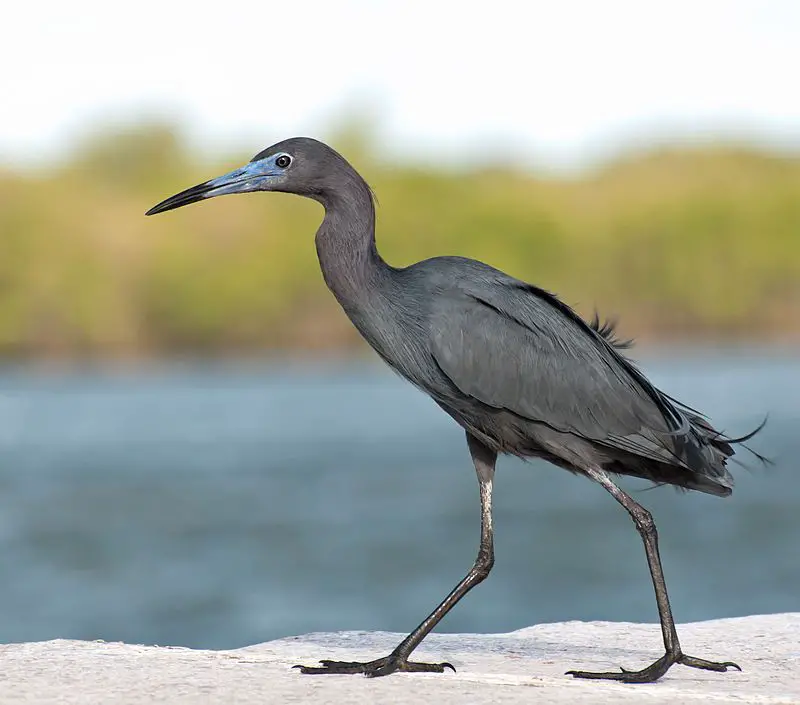
The little blue heron is a small heron of the genus Egretta. It is a small bird with dark blue plumage and a two-toned bill. Young herons are entirely white, giving them a strong resemblance to the snowy egret.
Adults, however, develop a variety of different colors on the head, legs, and feet during the breeding season. These colors can range from light gray to deep blue-black, depending on the species.
The most common coloration in adult little blue herons is a slate gray head and neck, with a reddish-brown breast and a white belly. The legs and feet are usually a yellowish-green color, with some blue or black markings.
The bill is a two-toned gray and black, with a sharp point. The eyes are dark brown. Little blue herons are found in freshwater marshes, shallow ponds, and other wetland habitats throughout North America.
They usually feed on small fish, insects, amphibians, crustaceans, and worms. These birds are shy and solitary, preferring to stay away from other birds and people. During the breeding season, they will form colonies in wetlands with suitable nesting areas.
They build their nests in trees or shrubs close to the water. Little blue herons are usually seen in small groups or pairs, although they can be found in larger flocks at times.
| Kingdom | Animalia |
| Phylum | Chordata |
| Class | Aves |
| Order | Pelecaniformes |
| Family | Ardeidae |
| Genus | Egretta |
| Species | E. caerulea |
7. Cerulean Warbler
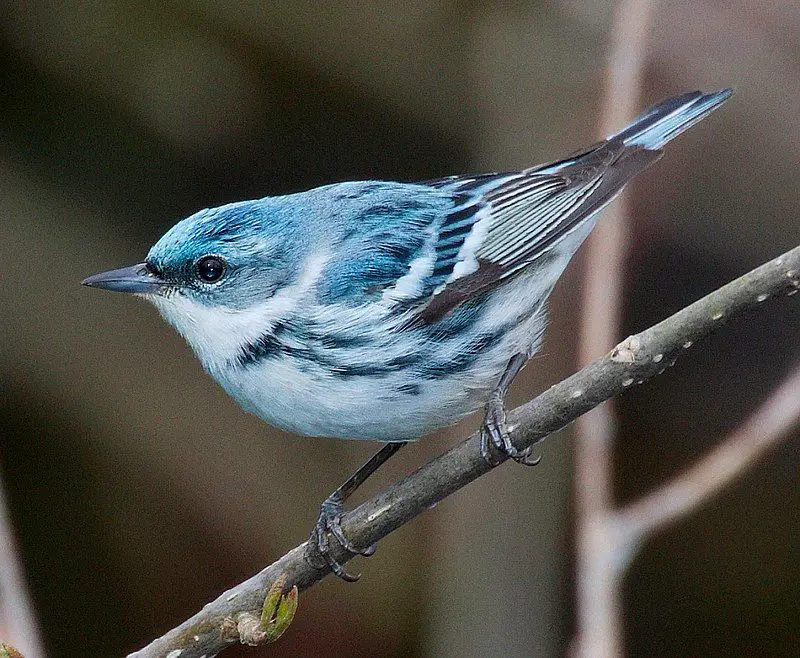
The cerulean warbler is a small songbird belonging to the Parulidae family. This species is known to be a long-distance migrant, meaning it migrates long distances between its breeding and non-breeding seasons.
During the breeding season, the cerulean warbler can be found in eastern North American hardwood forests. In the non-breeding season, it travels to the eastern slope of the Andes in South America, where it prefers subtropical forests for its habitat.
This species is well known for its long migration route, making it a fascinating bird to study. Its migration route from North America to South America is essential for its survival, as it is able to find suitable habitats for both its breeding and non-breeding seasons.
Understanding the migration patterns of this species is important to ensure its survival, as well as to help researchers learn more about the effects of climate change on migratory species.
| Kingdom | Animalia |
| Phylum | Chordata |
| Class | Aves |
| Order | Passeriformes |
| Family | Parulidae |
| Genus | Setophaga |
| Species | S. cerulea |
8. Blue-Gray Gnatcatcher
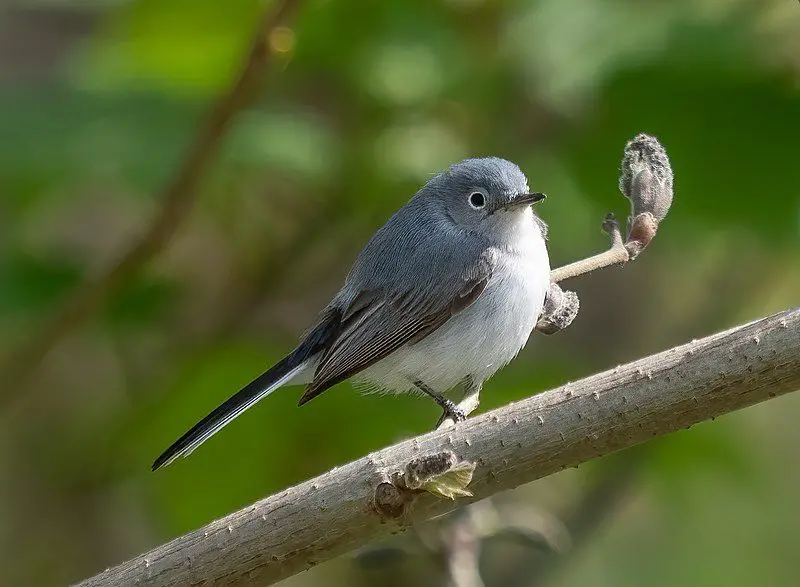
The blue-gray gnatcatcher, also known as the blue-grey gnatcatcher, is a small passerine bird native to North America. It belongs to the family of small insect-eating birds known as the Polioptilidae and is found in the United States, Canada, and parts of Mexico.
The blue-gray gnatcatcher is a very small bird, measuring only around 4 inches in length and weighing about 0.2 ounces.
It has a distinctive blue-gray plumage that sets it apart from other small songbirds, and it is a perching bird that usually feeds on small insects, such as gnats, flies, and other invertebrates.
The blue-gray gnatcatcher is usually found in open woodlands, shrubby areas, and forested habitats. It is an active and vocal bird, and can often be seen flitting from branch to branch in search of food.
The blue-gray gnatcatcher is an important part of the North American avian community, and its population has been steadily increasing in recent years.
| Kingdom | Animalia |
| Phylum | Chordata |
| Class | Aves |
| Order | Passeriformes |
| Family | Polioptilidae |
| Genus | Polioptila |
| Species | P. caerulea |
9. American Robin

The American robin is a type of migratory bird that belongs to the true thrush genus and Turdidae, also known as the wider thrush family.
This species of bird is named after the European robin due to its reddish-orange breast, which is similar in appearance to the European robin. Despite the similarities in their appearance, the two species are not closely related.
The European robin belongs to the Old World flycatcher family, while the American robin belongs to the true thrush genus and Turdidae.
The American robin is a highly recognizable bird species in North America, with its distinctive reddish-orange breast, brown back, and gray head. The American robin is a medium-sized bird, with an average weight of around two ounces.
It has a wingspan of about 11 inches and a body length of around 10 inches. This species of bird is found across much of North America, from Alaska to Newfoundland, south to Mexico, and parts of Central America.
The American robin is a diurnal bird, meaning it is active during the day. It feeds mainly on insects, earthworms, fruits, and berries. During the summer months, the American robin migrates to cooler climates, flying south from its breeding grounds in the north.
In the winter, the American robin migrates back north to its breeding grounds. The American robin is an important species of bird in North America, as it helps to maintain healthy ecosystems.
By feeding on insects, earthworms, fruits, and berries, the American robin helps to keep pest populations in check. It also serves as an important pollinator for many plants, helping to ensure the health and growth of those plants.
Overall, the American robin is a highly recognizable and important species of bird in North America. With its distinctive reddish-orange breast and brown back, it is easily identified and serves an important role in its ecosystem.
Despite its similarities to the European robin in appearance, these two species are not closely related. The American robin belongs to the true thrush genus and Turdidae, while the European robin belongs to the Old World flycatcher family.
| Kingdom | Animalia |
| Phylum | Chordata |
| Class | Aves |
| Order | Passeriformes |
| Family | Turdidae |
| Genus | Turdus |
| Species | T. migratorius |
10. White-Breasted Nuthatch
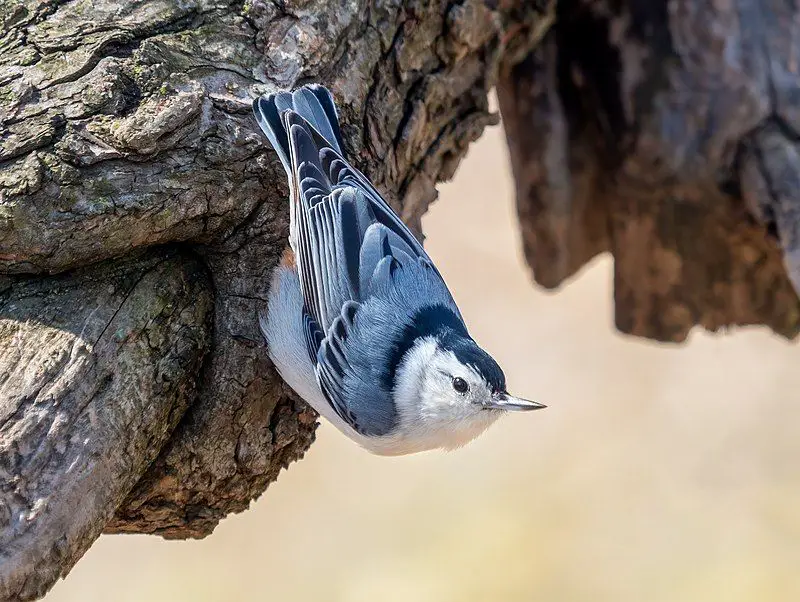
The white-breasted nuthatch is an impressive species of bird that belongs to the nuthatch family, Sittidae. It is a medium-sized bird, typically measuring around 15.5 cm in length. It has a striking appearance, with a white chest and grey back.
Its head is black, and its wings and tail are blue-grey. The white-breasted nuthatch has a short, stout bill that is adapted for foraging in trees, where it is able to cling to the bark to reach the insects and seeds that make up its diet.
It is a vocal bird and its call is a loud, high-pitched “yank-yank” sound. The white-breasted nuthatch is a widespread species, found in North America, Europe, and Asia. It nests in cavities in trees, often using abandoned woodpecker holes.
It is a popular backyard bird, and its presence in the garden can be an indication of a healthy ecosystem.
| Kingdom | Animalia |
| Phylum | Chordata |
| Class | Aves |
| Order | Passeriformes |
| Family | Sittidae |
| Genus | Sitta |
| Species | S. carolinensis |
11. Belted Kingfisher
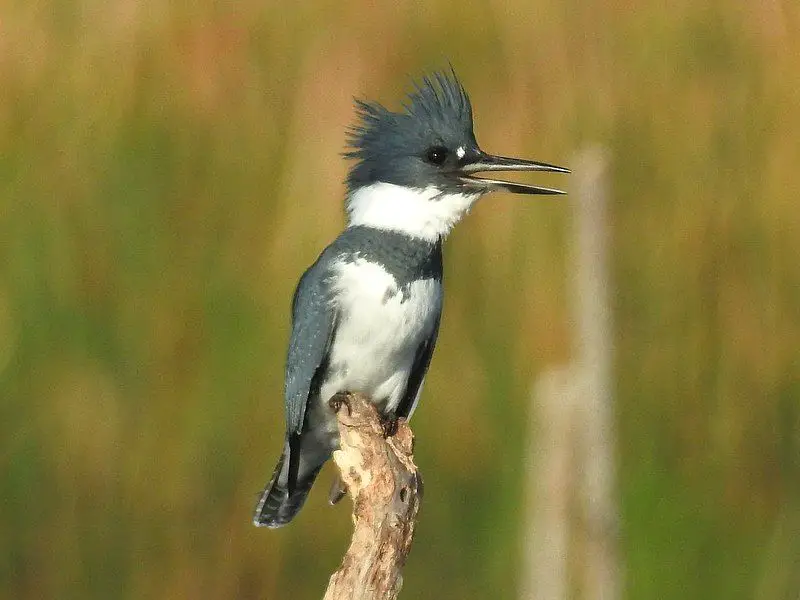
The belted kingfisher is a large, distinctive bird that can be found near bodies of water in North America. It is one of many species of kingfisher, which have traditionally been grouped together in the family Alcedinidae.
However, recent research has suggested that this group should be broken down further into three subfamilies.
This means that the kingfishers can be divided into more specific categories based on their features, such as their size, body shape, beak shape, and other physical characteristics.
This allows for a more in-depth understanding of the various species and how they are related to one another. By studying these subfamilies, experts can better understand the evolution of the Kingfisher family and how they have adapted over time.
| Kingdom | Animalia |
| Phylum | Chordata |
| Class | Aves |
| Order | Coraciiformes |
| Family | Alcedinidae |
| Genus | Megaceryle |
| Species | M. alcyon |
12. Red-Winged Blackbird
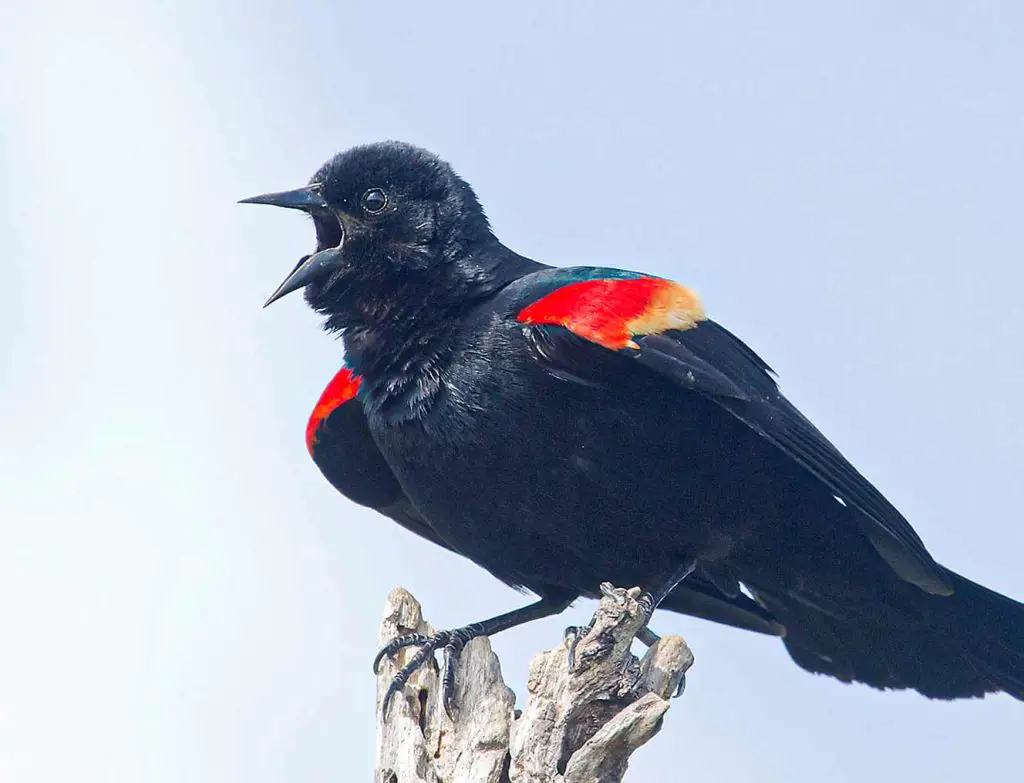
Source: vtecostudies.org
The red-winged blackbird is a passerine bird, also known as a songbird. It is a member of the Icteridae family and is found throughout North America and Central America, inhabiting a wide range of habitats from marshes to open fields.
It is an adaptable bird, often seen in large flocks and it is well known for its melodious song. The red-winged blackbird is primarily black in color with distinctive red and yellow patches on the wings.
Males are more brightly colored than females, and have a yellow-tinted head, while the female’s head is a darker brown. Its diet consists mainly of insects, spiders, and other invertebrates, as well as some seeds, berries, and grains.
Red-winged blackbirds are a common sight in many regions, providing a vital link in the food chain for the many species that feed on them.
| Kingdom | Animalia |
| Phylum | Chordata |
| Class | Aves |
| Order | Passeriformes |
| Family | Icteridae |
| Genus | Agelaius |
| Species | A. phoeniceus |
13. Common Grackle
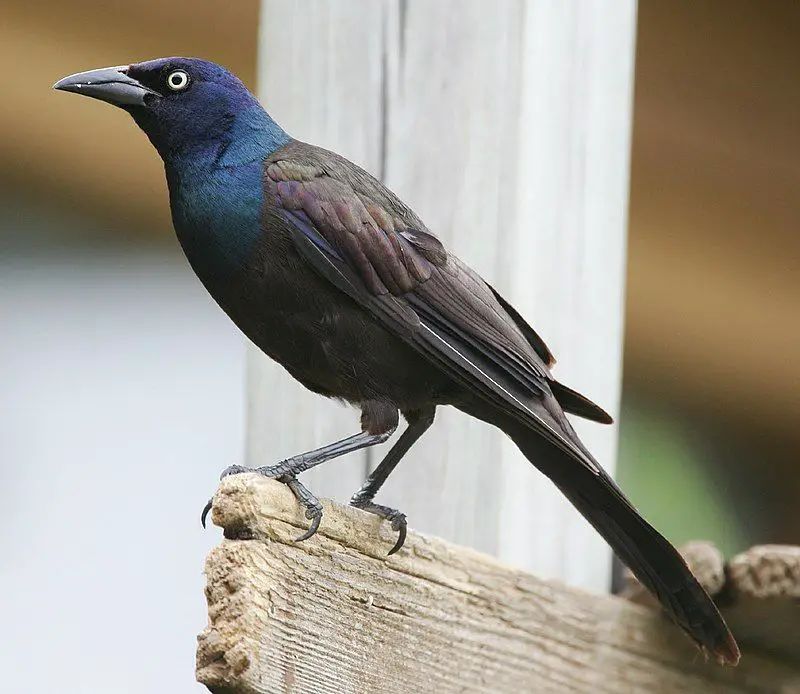
The common grackle is a species of bird belonging to the family Icteridae, which is found in abundance in North America. It was first described by Carl Linnaeus in 1758. Common grackles have a long and dark bill, pale yellow eyes, and a long tail.
There are three subspecies of the common grackle: the Great-tailed Grackle, the Boat-tailed Grackle, and the Common Grackle.
The Great-tailed Grackle is the largest of the three subspecies, with males between 17.7 and 21.6 inches (45 and 55 cm) long and weighing up to 8.8 oz (250 g). It has a long and slender bill, and its plumage is mainly iridescent black with a purple or greenish sheen.
The Boat-tailed Grackle is smaller than the Great-tailed Grackle, measuring between 12.2 and 17.7 inches (31 and 45 cm) in length. It has a shorter, thicker bill, and yellow eyes, and its plumage is a mix of black, brown, and greenish-yellow.
The Common Grackle is the smallest of the three subspecies, measuring 11.8 to 14.2 inches (30 to 36 cm) in length. It has a short and thick bill, and its plumage is mostly black, but it can have a greenish or purplish sheen.
Common grackles have a wide range of habitats, including grasslands, woodlands, marshes, cities, and agricultural areas. They are omnivorous, eating insects, grains, seeds, and fruits. They are also known to eat eggs, nestlings, and small mammals.
Common grackles are social birds and can often be seen in large flocks.
They are known for their loud and raucous calls, which can be heard from long distances. The common grackle is an important species in North America, as it helps to control insect populations and disperse seeds.
It is also a popular bird for bird watchers, as it is often seen in large numbers and its striking plumage makes it easy to spot.
| Kingdom | Animalia |
| Phylum | Chordata |
| Class | Aves |
| Order | Passeriformes |
| Family | Icteridae |
| Genus | Quiscalus |
| Species | Q. quiscula |
14. Tufted Titmouse
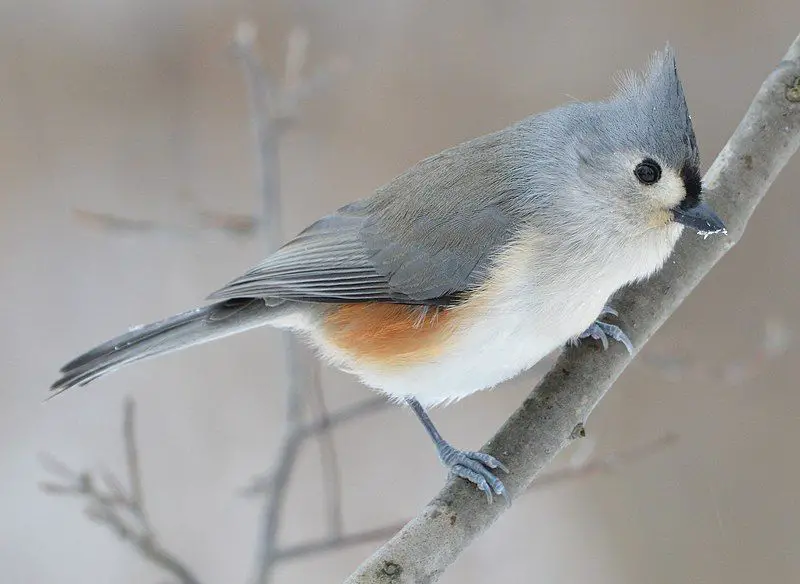
The tufted titmouse is a small songbird found in North America and is a part of the tit and chickadee family. It is a gray bird with a white underside and a black forehead crest. It is usually found in deciduous forests and woodlands, but can also be found in residential areas.
Its diet consists of mostly insects and seeds, and it can often be seen at bird feeders. The black-crested titmouse, also known as Baeolophus atricristatus, is native to central and southern Texas.
It is similar in appearance to the tufted titmouse but is distinguished by its black crest. Its range is mostly limited to the south of Texas, and it is typically found in woodlands and oak savannas.
Its diet consists of insects, seeds, and fruit, and it is also attracted to bird feeders. At one point, the black-crested titmouse was considered to be a subspecies of the tufted titmouse, but now it is recognized as a separate species.
This is likely due to the differences in their physical appearance and range, as well as their different dietary preferences.
| Kingdom | Animalia |
| Phylum | Chordata |
| Class | Aves |
| Order | Passeriformes |
| Family | Paridae |
| Genus | Baeolophus |
| Species | B. bicolor |
15. Brown-Headed Cowbird
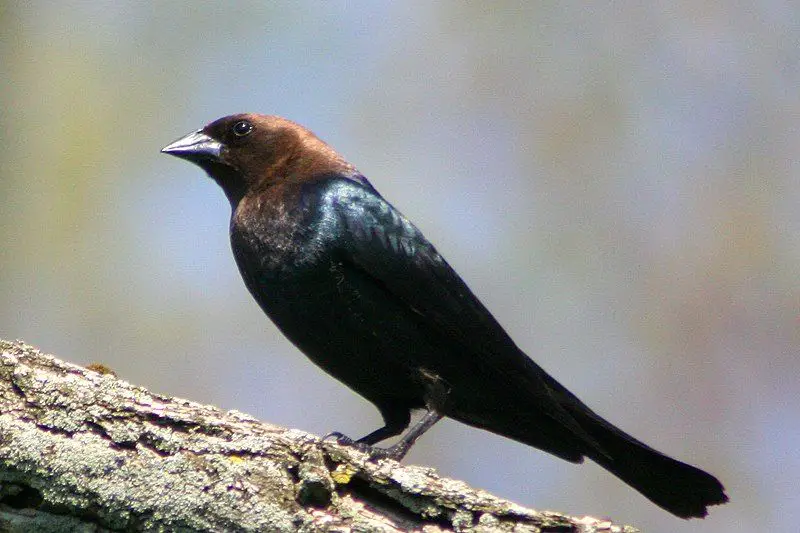
The brown-headed cowbird is a species of icterid, a family of birds native to North America. It is a small bird, measuring only around 6.3 inches long, with a short tail and a distinctive brown head.
This bird is an obligate brood parasite, meaning that it lays its eggs in the nests of other birds, leaving the incubation and caring of its young to the foster parents.
This species is found in temperate and subtropical regions of North America, with individuals in the northern parts of its range migrating to the southern United States and Mexico during winter.
Northern birds begin to return to their summer habitats in March or April, while southern birds remain year-round.
This species is considered to be an important part of the avian ecosystem, as its presence helps to disperse seeds, maintain nest sites, and control insect populations.
| Kingdom | Animalia |
| Phylum | Chordata |
| Class | Aves |
| Order | Passeriformes |
| Family | Icteridae |
| Genus | Molothrus |
| Species | M. ater |
16. Great Blue Heron

The great blue heron is a majestic bird that can be found in many different parts of the world. It belongs to the heron family Ardeidae, which is found in North and Central America, South America, the Caribbean, and the Galápagos Islands.
This species of bird is known for its large size and for its habit of wading in shallow waters. The great blue heron can be seen around the shores of lakes, rivers, and other bodies of open water. It is also frequently seen in wetlands, such as swamps, marshes, and mudflats.
It is a common sight near the coasts of many of the continents and islands mentioned above. The great blue heron typically hunts for small fish, frogs, and other aquatic creatures. It can be seen standing in the shallow waters, waiting for its prey to come close.
The great blue heron can also be found in shallow pools of water where it will search for food. The great blue heron is a magnificent bird that can be found in many different parts of the world.
It is a common sight near the shores of open water and in wetlands, and it is an important part of many ecosystems.
| Kingdom | Animalia |
| Phylum | Chordata |
| Class | Aves |
| Order | Pelecaniformes |
| Family | Ardeidae |
| Genus | Ardea |
| Species | A. herodias |
17. Red-Breasted Nuthatch
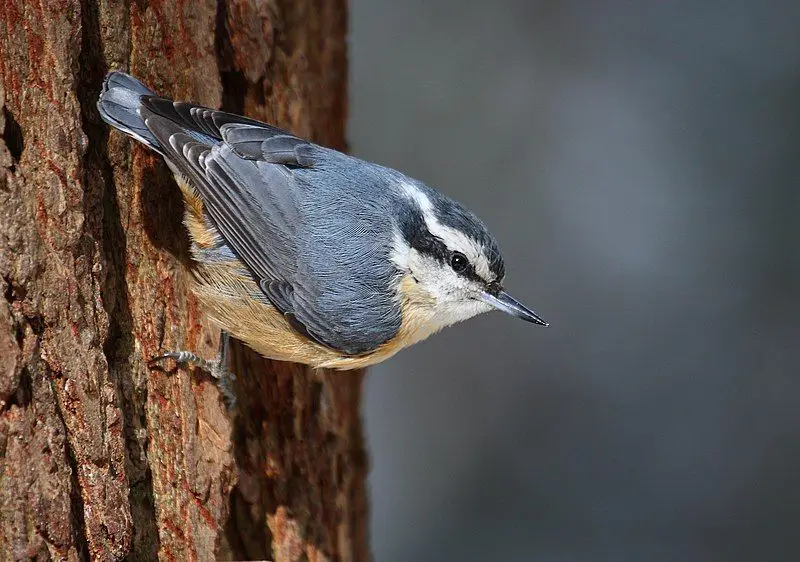
The red-breasted nuthatch is a small songbird with distinctive coloration. The adult has bright blue-grey upperparts that contrast with the cinnamon color of their underparts. The nuthatch has a white throat and face with a black stripe running through the eyes.
It has a straight grey bill and a black crown. This bird is also known for its call, which can be likened to a tin trumpet. The sound is high-pitched and nasal in quality.
The red-breasted nuthatch can be found in a variety of habitats, including deciduous forests, coniferous forests, and urban and suburban areas. It is a common sight in many parts of the United States and Canada during the breeding season.
Outside of the breeding season, some of the nuthatches migrate south in search of food and more favorable temperatures. The red-breasted nuthatch is well adapted to forage for food in a variety of ways. It will feed on seeds, nuts, insects, and other small invertebrates.
It will also use its bill to pry off bark from trees in order to access larvae and other insects beneath. The nuthatch is an important species in its habitat, as it helps to keep insect populations in check.
The red-breasted nuthatch is an interesting and important species in its habitat. Its distinct coloration and call make it easy to spot in the wild, and its foraging habits help to keep insect populations in check.
This small songbird is a common sight in many parts of the United States and Canada and is a favorite among birders.
| Kingdom | Animalia |
| Phylum | Chordata |
| Class | Aves |
| Order | Passeriformes |
| Family | Sittidae |
| Genus | Sitta |
| Species | S. canadensis |
18. House Finch
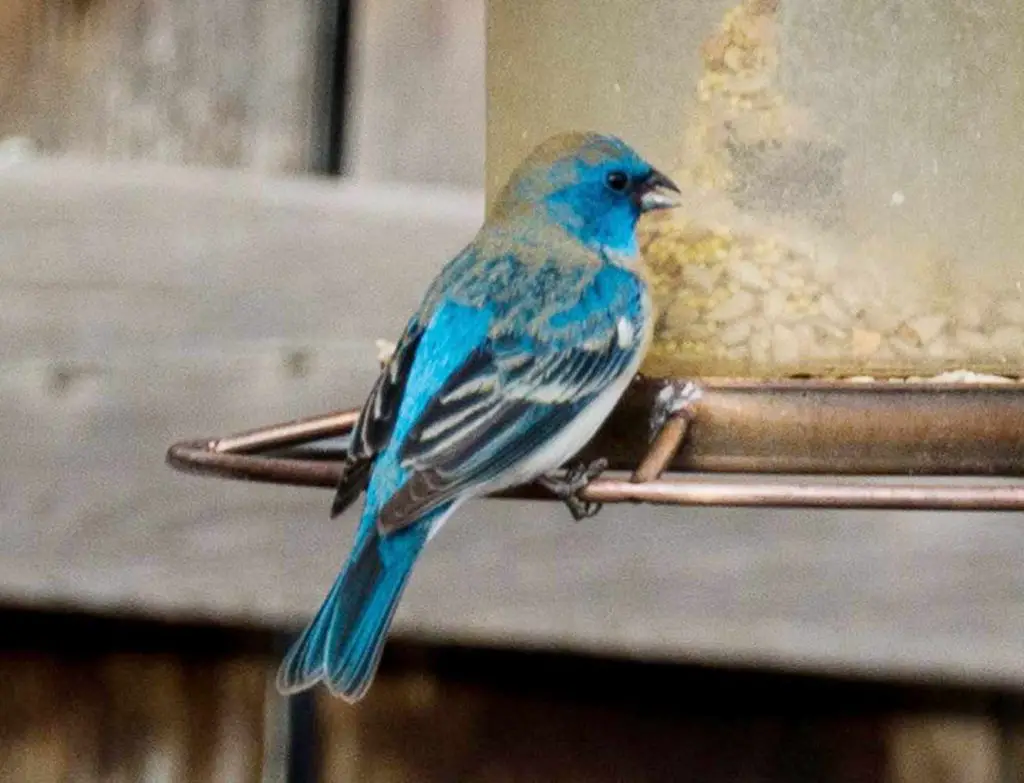
Source: reddit.com
The house finch (Haemorhous mexicanus) is a species of finch found in the Fringillidae family. It is native to western North America, ranging from Alaska and Canada in the north to Mexico and the Caribbean in the south.
It has also been introduced to parts of the eastern United States, Hawaii, and other parts of the world. The house finch is a medium-sized bird, typically measuring around 15 cm (6 in) in length.
It is brownish-gray in color, with white or yellowish markings on its chest and wings. Males are generally brighter in color than females. The house finch feeds mainly on seeds, fruits, and insects.
It often visits backyard bird feeders, particularly in the winter months. The house finch, along with the other two American rosefinches, is placed in the genus Haemorhous. All three species are similar in size and shape, but the house finch is the most widely distributed.
It is also the most common species of finch in North America.
| Kingdom | Animalia |
| Phylum | Chordata |
| Class | Aves |
| Order | Passeriformes |
| Family | Fringillidae |
| Genus | Haemorhous |
| Species | H. mexicanus |
19. Gray Catbird
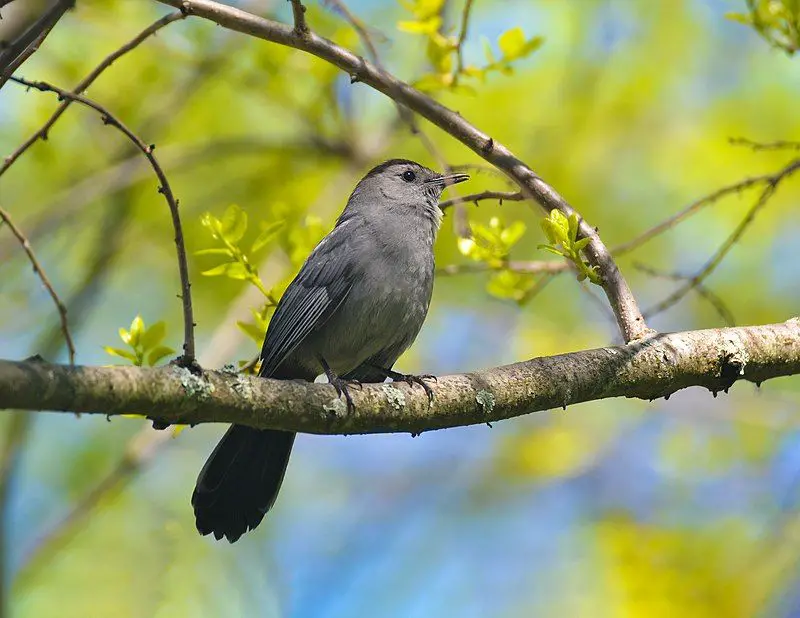
The gray catbird, also spelled grey catbird, is a medium-sized bird that is found in both North and Central America. It is a member of the mimid family, which is a group of birds known for their ability to mimic sounds from their environment.
The gray catbird is the only species in the genus Dumetella, a genus that is named for its distinct call, which is similar to the sound of a cat meowing. This species has a gray body and a black cap, with a white patch on its throat and tail.
Its wings are dark gray, and its legs are black. The gray catbird is a common bird in North America, where it can be found in urban and suburban areas as well as in woodlands and forests.
It is also found in Central America, where it inhabits a variety of habitats, including tropical forests, mangroves, and swamps. The gray catbird is an omnivorous bird that eats both insects and fruits.
It often forages on the ground, searching for food such as beetles, grasshoppers, and caterpillars. In addition to its diet of insects, the gray catbird also eats fruits, berries, and seeds.
The gray catbird is an important part of the ecosystem, as it helps to control insect populations and disperses the seeds of many different plants.
| Kingdom | Animalia |
| Phylum | Chordata |
| Class | Aves |
| Order | Passeriformes |
| Family | Mimidae |
| Genus | Dumetella |
| Species | D. carolinensis |
20. New World Warblers
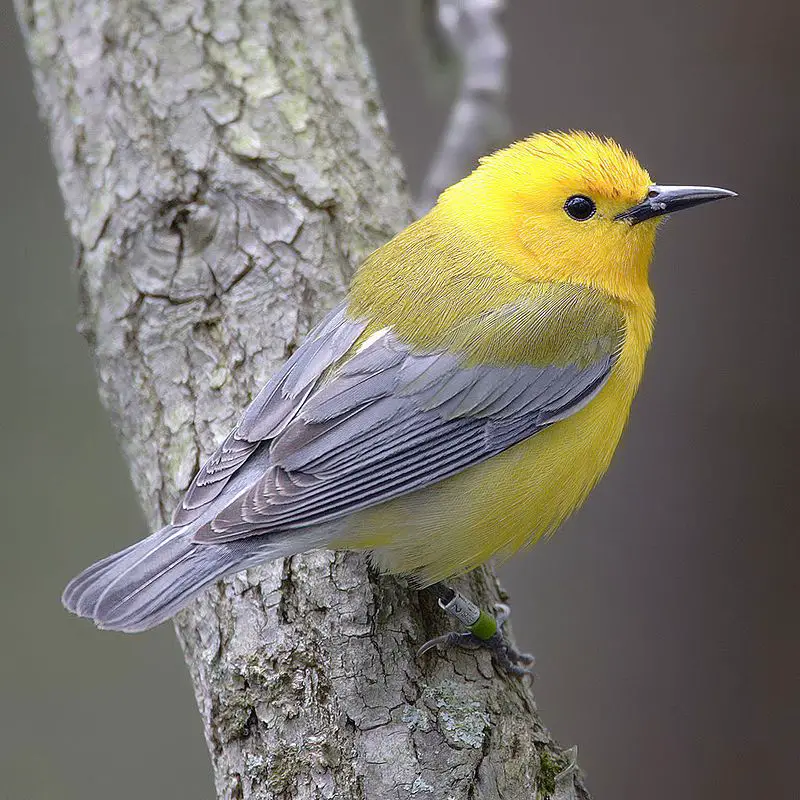
The New World warblers, which are also known as wood-warblers, are a family of small passerine birds found exclusively in the New World. These birds are characterized by their vibrant colors and are part of the family Parulidae.
The New World warblers are not closely related to Old World warblers or Australian warblers, which are members of completely different families. The Parulidae family is made up of over 70 species of small passerines, each with its own unique features.
These birds are typically found in North and South America, and they come in a variety of shapes and sizes. The most common colors found in New World warblers include yellow, green, and blue, but some species are known to have more vibrant red and orange hues.
New World warblers have a variety of behaviors, but they are primarily insectivores and eat mostly small invertebrates such as spiders, beetles, and caterpillars. They are also known to eat some fruits, especially during the breeding season.
The birds often use their long beaks to feed on nectar from flowers. These birds typically build nests in tree cavities or on the ground. The nests are usually constructed from grass, leaves, and other materials and lined with feathers.
The males are usually the ones responsible for building the nest, while the females take care of the eggs and young. New World warblers are important to the environments they inhabit as they help to control insect populations and provide food for other animals.
They are also important to humans, as some of these birds are popular as pets.
| Kingdom | Animalia |
| Phylum | Chordata |
| Class | Aves |
| Order | Passeriformes |
| Family | Parulidae |
21. American Goldfinch
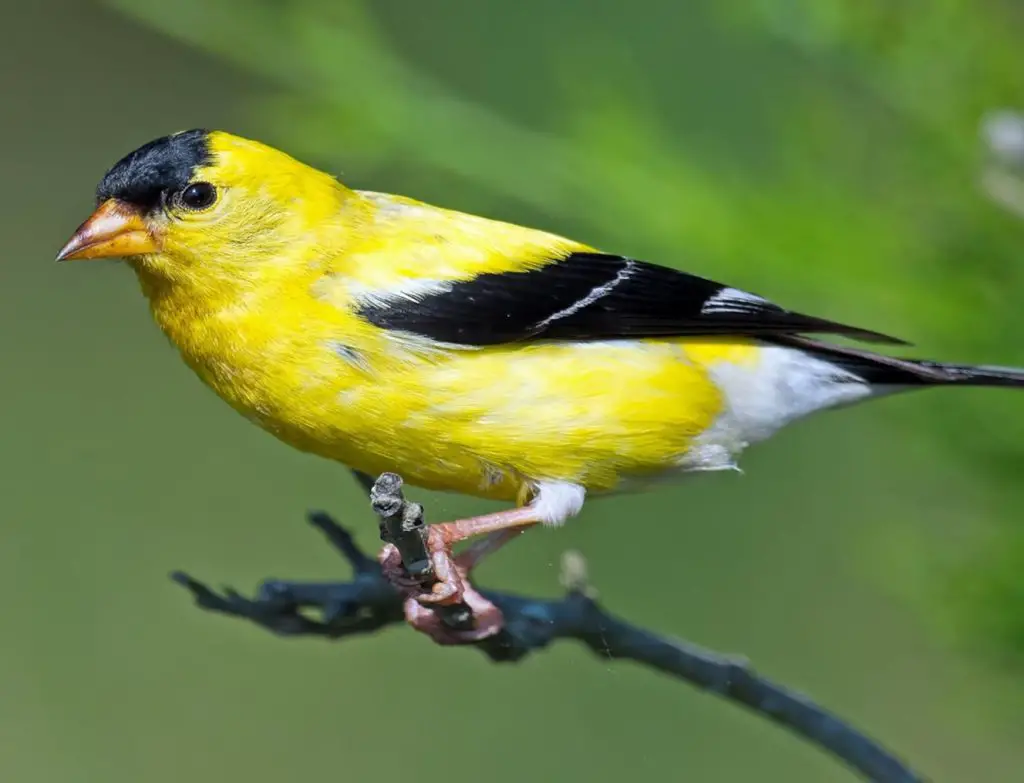
Source: kids.nationalgeographic.com
The American goldfinch is a small bird that belongs to the finch family. It is found in North America, primarily in the mid-Alberta region, and can be spotted as far south as North Carolina during the breeding season.
During the winter months, the American goldfinch migrates south to just past the Canada-United States border and can be found as far south as Mexico. The American goldfinch is a beautiful bird with bright yellow and black plumage.
Its wings have a reddish hue, and males possess a red patch on their foreheads. These birds are a common sight in parks and gardens and their diet primarily consists of seeds from various plants. They are social birds that often flock together in large groups.
The American goldfinch is an important species for the North American ecosystem. It helps to disperse the seeds of various plants, contributing to a healthy and diverse plant population. It also provides food for other animals, such as small mammals and other birds.
As a result, the American goldfinch is an important part of the food chain in the North American region.
| Kingdom | Animalia |
| Phylum | Chordata |
| Class | Aves |
| Order | Passeriformes |
| Family | Fringillidae |
| Genus | Spinus |
| Species | S. tristis |
22. Northern parula
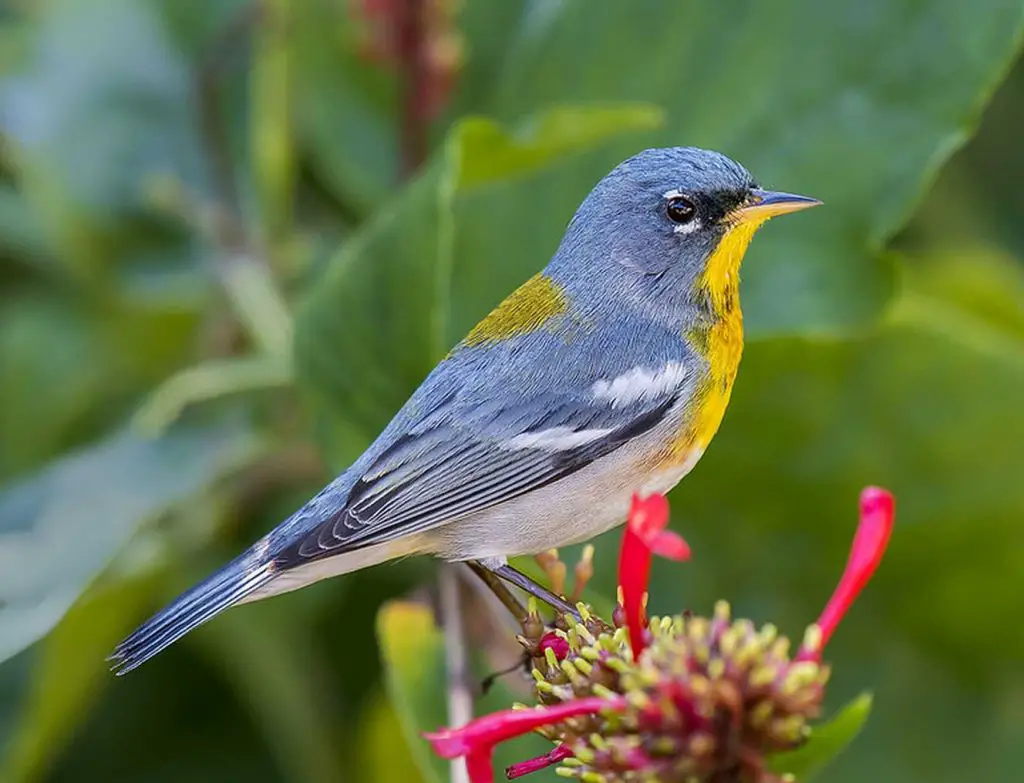
Source: dibird.com
The northern parula is a species of warbler that is native to the New World, which means it is found in the Americas. It is a small bird with a bright yellow throat, a bluish-green back, and white bands on its wings.
Its range extends from southern Canada down to Florida in the United States. It breeds in the eastern part of North America and is a common sight in the deciduous and mixed forests, as well as in the swamps and wetlands of the region.
During the breeding season, it builds its nest in the forks of trees, usually in the higher branches. It feeds on insects, spiders, and other small invertebrates and sometimes on small fruits.
The northern parula is an important part of the local ecosystem, as it helps to control insect populations and disperse the seeds of fruit-bearing plants.
| Kingdom | Animalia |
| Phylum | Chordata |
| Class | Aves |
| Order | Passeriformes |
| Family | Parulidae |
| Genus | Setophaga |
| Species | S. Americana |
23. Common Starling
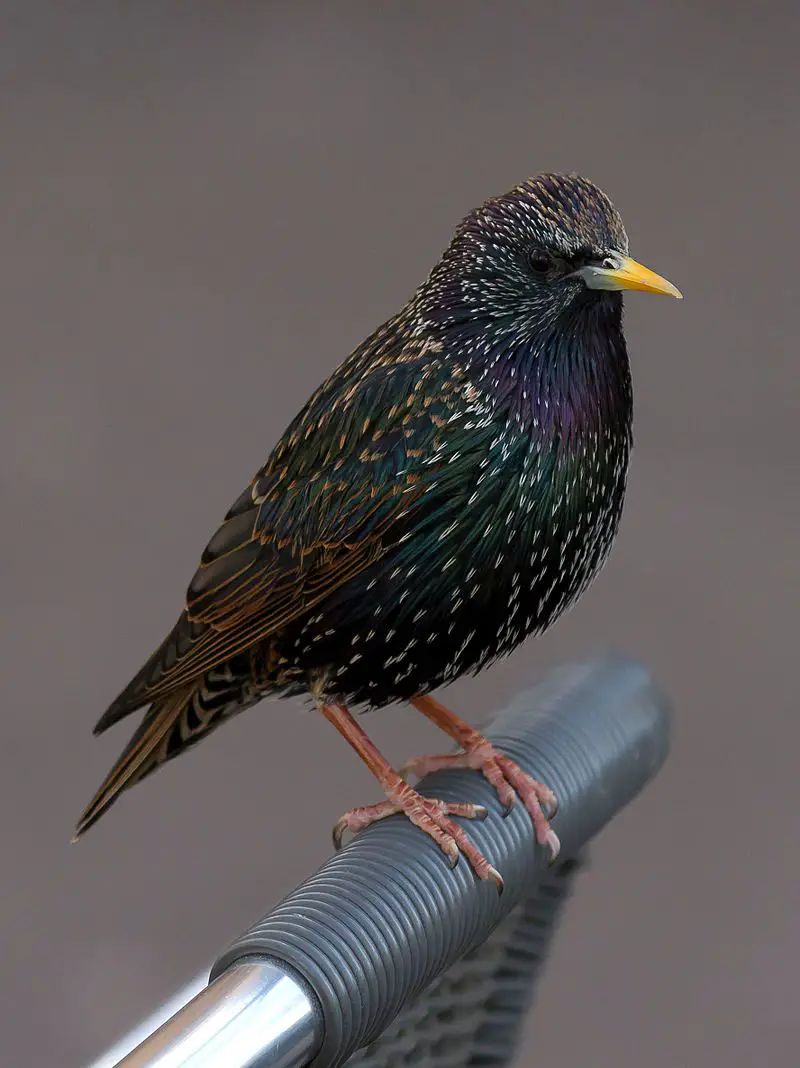
The Common Starling is a species of bird that is native to Europe, parts of Asia, and North America. It belongs to the Sturnidae family, a group of passerine birds, which are medium-sized and characterized by their pointed wings and long, pointed bills.
In the United Kingdom and Ireland, they are simply known as Starlings, while in North America they are referred to as European Starlings. The Common Starling can be identified by its distinctive black and white speckled feathers.
Its plumage is largely iridescent in the light, giving it a glossy appearance. The Common Starling is a highly social species, often forming large flocks and nesting in colonies. They feed on insects and other invertebrates, supplementing their diet with fruits and seeds.
The Common Starling is a vocal bird, with a wide repertoire of sounds. They are also quite smart and have been known to mimic the calls of other bird species. They are also known to roam in large numbers, often congregating in large flocks that are visible during flight.
This makes them a common sight in the skies of Europe and North America.
| Kingdom | Animalia |
| Phylum | Chordata |
| Class | Aves |
| Order | Passeriformes |
| Family | Sturnidae |
| Genus | Sturnus |
| Species | S. vulgaris |
24. Blue Grosbeak
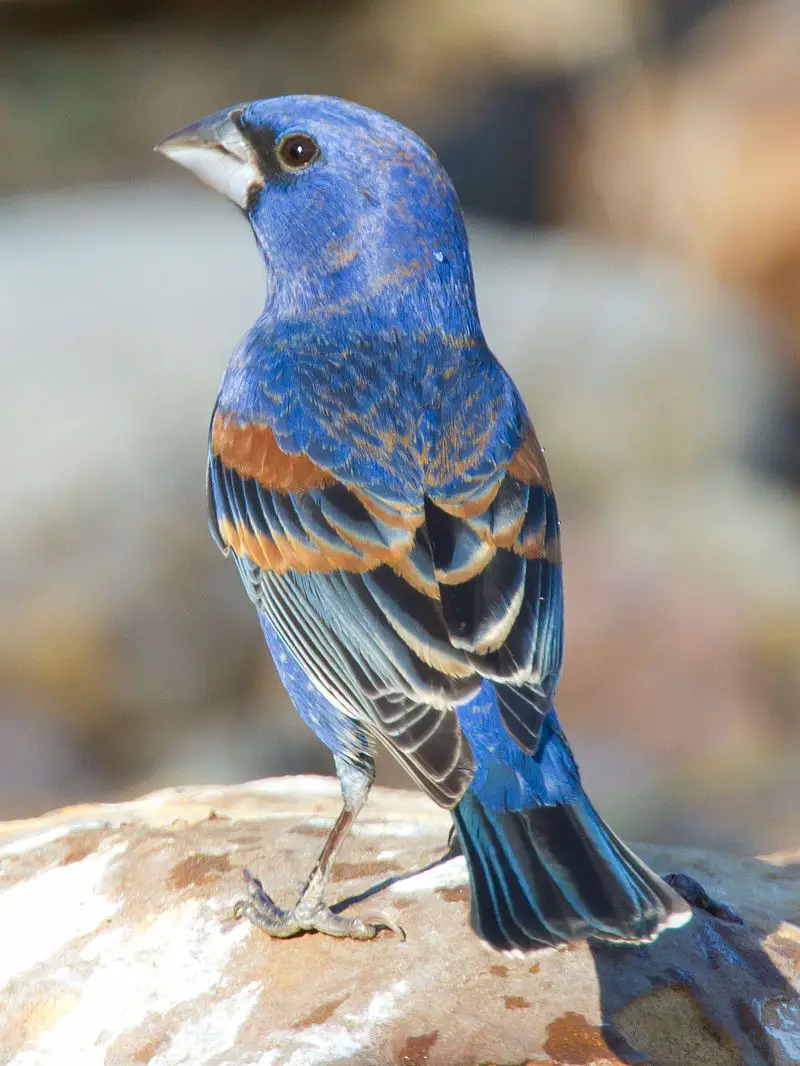
The blue grosbeak is a medium-sized passerine bird native to North America. It is a member of the Cardinalidae family and is mainly migratory.
During the winter months, it can be found in Central America, while in the summer, it breeds in northern Mexico and the southern United States. Male blue grosbeaks are easily identified by their bright blue color and two brown wing bars.
Females of this species have a grey-brown coloration, with a distinctive yellow spot on their wings. These birds have a distinctive, melodious song, and feed mainly on insects, seeds, berries, and grains. They can be found in open woodlands, fields, and near rivers.
| Kingdom | Animalia |
| Phylum | Chordata |
| Class | Aves |
| Order | Passeriformes |
| Family | Cardinalidae |
| Genus | Passerina |
| Species | P. caerulea |
25. Painted Bunting
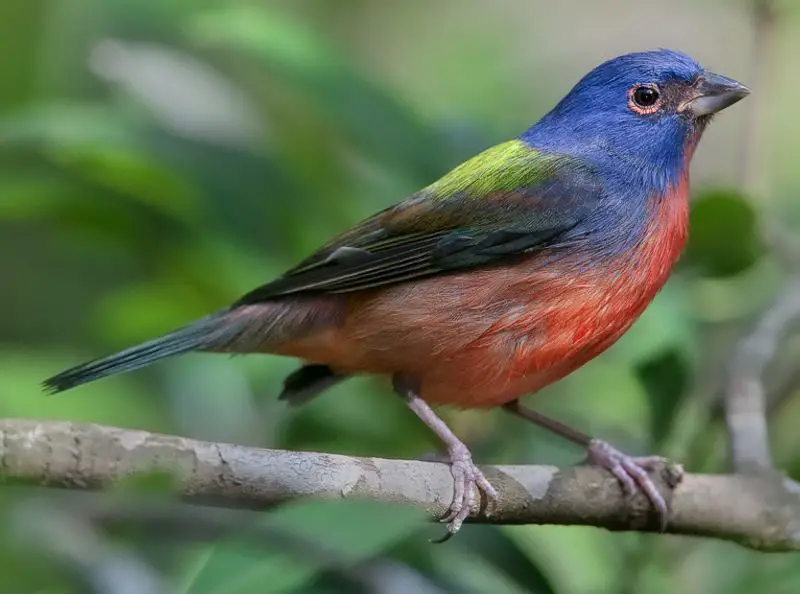
The painted bunting is a species of bird in the cardinal family, Cardinalidae. It is native to North America and is easily recognized by its bright, colorful plumage. The male of the species has the most vibrant coloring, which typically only develops in its second year.
This means that in its first year, the male can only be distinguished from the female by close inspection. The female is usually a much more dull color. The painted bunting is a beautiful species of bird and is often found in gardens and wooded areas.
They are also known to flock together in large numbers, making it easier to spot them in the wild.
| Kingdom | Animalia |
| Phylum | Chordata |
| Class | Aves |
| Order | Passeriformes |
| Family | Cardinalidae |
| Genus | Passerina |
| Species | P. Ciris |
Conclusion
Blue birds are a beautiful and important species in Massachusetts, providing essential ecosystem services and adding beauty to the landscape.
Despite their declining numbers, blue birds can still be found in Massachusetts, where they can be seen in open fields and wooded areas. With increased habitat management, protection, and conservation efforts, blue birds can continue to thrive in Massachusetts.